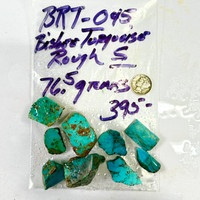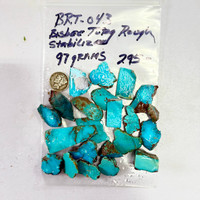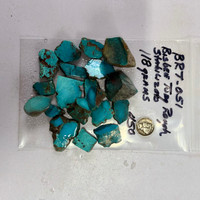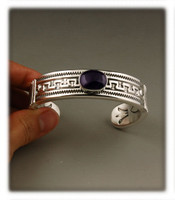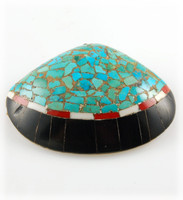 Loading... Please wait...
Loading... Please wait...- 970-759-1040 Text / Voice
- Gift Certificates
- My Account
Currency Displayed in
- Home
- Turquoise Learning Center
- Turquoise Information
- Turquoise Properties
Categories
Turquoise Properties
Turquoise Properties
Turquoise Properties
Turquoise is an opaque gemstone with a wide color range from sky blue to deep green. It's high grade is rare and valuable. There are many Turquoise properties that vary and determine worth.
Turquoise was one of the first gemstones found by mankind and has been prized by many cultures for thousands of years.
Turquoise Properties: In the language of chemists and geologists the physical Turquoise Properties are:
hydrated phosphate of aluminum and copper (copper aluminum phosphate) or CuAl6((OH)2/PO4)4 CuAl6(PO4)4(OH)8 + 4H2O.
Chem: CuAl6(PO4)4(OH)8 * 5H2O Hydrous copper - aluminum phosphate
Color: pale blue, sky blue, dark "sky" blue, all ranges of bluish-green, pale green to dark "forest" green
Refrac. Index: 1.61 - 1.65
Birefraction: 0.04
Hardness: 3.5 - 6
Specific Gravity: 2.6 to 2.8
Cleavage: none
Fracture: conchoidal, uneven
Transparency: opaque
Chemical Makeup of Turquoise: CuAl6((OH)2/PO4)4 CuAl6(PO4)4(OH)8 + 4H2O
Luster: waxy, vitreous in macro-crystal and associations
Turquoise Properties - color and charicteristics
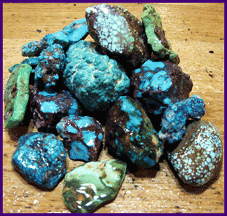 |
Turquoise comes in all shades of blue as well as green and in some rare instances lime green, yellow and even brown turquoise. Turquoise properties in general, are different by geographical location - blue Turquoise is from Arizona and Green Turquoise is from Nevada. Colorado and New Mexico have both blue and green Turquoise, however, the highest concentrates of Turquoise in America comes from Arizona and Nevada. The Turquoise properties in all Turquoise make it an opaque gemstone. Turquoise from all areas, worldwide, contain impurities that form matrix streaks within the stones. The veins are inclusions from nearby rock fragments or oxides and form during the creation of Turquoise. These matrix veins or streaks can contain sandstones, limonite, mangonese and psilomelane as well as many other types of host rock native to the specific area the Turquoise is found in . The veins in some stones interlock in patterns to form "spider-web" turquoise which is considered the rarest form of Turquoise. There are many natural phenominons that accured in the formation of Turquoise that makes it unique to itself. The physical properties of Turquoise do not allow for white Turquoise, so the idea of natural white Turquoise is actually a myth and not true. Two types of Turquoise are most valuable due to their inherant rarity, clear Robbins Egg blue with no matrix and spiderwebbed Turquoise that has a webbed matrix which comes in several different colors due to the type of minerals that are in the particular area the Turquoise is located. Robins Egg Blue Turquoise was originally prized in Egypt where Turquoise was originally found over 7,500 years ago. Ancient Gods, Goddesses, Kings, Queens, Pharoahs and Spiritual leaders believed that Robbins Egg Blue Turquoise was the purest of all Turquoise, therefore it was the most valuable. Robbins Egg Blue was later found in Persia and then in Arizona at the Sleeping Beauty Turquoise Mine. Today, the major producer of Robbins Egg Blue Turquoise comes from the Sleep Beauty Turquoise Mine. The clear blue or not matrix Turquoise properties was most valued in earlier times. Spiderweb Turquoise - When it comes to Turquoise properties, spider web Turquoise, whose most valuable specimens are a spider web Turquoise in almost any color, robin's egg blue or deep-blue azure Turquoise in Europe, as well as some other rare looks such as Lime Green Turquoise, water web or birdseye matrix Turquoise, and pyrite matrix Turquoise. In American Turquoise the physical properties of Turquoise for spider web or pattern matrix bearing stones with great color which are the most valuable, most of which come from Arizona and Nevada. |
Turquoise Properties - Geological Environment
The common environment of Turquoise is arid or semiarid zones such as those that occur in Egypt, Iran or Southwestern United States. It is found in veins and nodules in weathered rhyolitic igneous rock, Manganese and chert where it forms as a secondary mineral of the process known as hydrothermal replacement depositing that occurs when chemicals leach out of nearby rock by way of rain or a saturated water table. Copper eroding from deposits leaches into cracks and combines with phosphates and other chemicals to form Turquoise.The precise Turquoise properties are rare in geology.
Turquoise Properties concerning the crystal habit of Turquoise
Nearly all Turquoise is cryptocrystalline, in fact, scientists had thought Turquoise was amorphous (non-crystal forming) until 1911, when crystalline specimens were found in Virginia. This Turquoise Properties are rare. The Turquoise crystal system is Triclinic, which is the least symmetrical of all crystal systems with all three axes of unequal lengths and none intersecting at right angles. The common shape for this system is the pinacoid. These rare conditions contribute to the chemical makeup of Turquoise as well as the physical Turquoise properties.
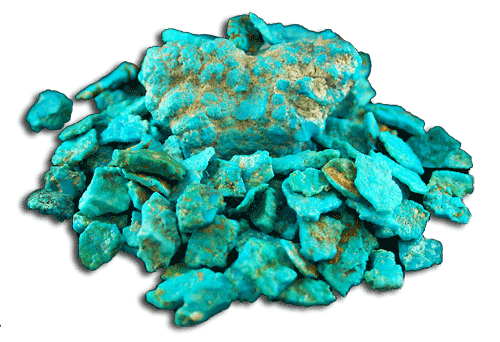
Chemical Enhancements on the Turquoise
Turquoise is a controversial stone because a lot of the stones sold have received so many chemical treatments that the final product is completely different from its original form. Enhancements can include, plastic, wax, oils as well as heat treatment change the color, durability and polish. Natural Turquoise that does not need any form of treatment is rare and exceptionally valuable in comparison to altered Turquoise. These Stones have all the Turquoise Properties but have been tampered with.
Imitators of Turquoise
Because of the rarity of fine specimens of Turquoise, jewelry makers have been creating imitations of it for centuries. The Egyptians used a glazed quartz paste as a substitute for the Turquoise for their jewelry requirements. The most common modern imitators of Turquoise are Howlite, Magnesite, Turquenite, dyed chalcedony, glasses, ceramics, and plastics. The minerals most often confused with Turquoise include Amazonite, Prosopite, Lazulite, Hemamorphite, Chrysocolla, Odontolite, Serpentine, Smithsonite, Faustite, and Variscite. Bone Turquoise or Vivianite (a hydrous ferrous phosphate) can leach into fossils and turn them a blue that is close to Turquoise in color. These stones produce now natural Turquoise properties.
Reconstituted Turquoise - The process of reconstituting Turquoise consists of pulverizing pieces of turquoise that are then stabilized and hardened with resins to achieve a natural Turquoise appearance. Resin-reconstituted Turquoise usually has an odor that allows for detection.
Lab-Grown Synthetic Turquoise: Also known as Neo-turquoise, Hamburger Turquoise or Neolite. Lab-grown Turquoise does not have the veins of impurities found in most American Turquoise. The refractive index of natural Turquoise is usually slightly higher than that of lab-grown stones. Genuine specimens also have homogenous blue matrices that contain irregular white particles. These stones produce now natural Turquoise properties.
Turquoise Care
The most common dangers to Turquoise are scratches, sharp blows and household chemicals, including hot soapy water. Because Turquoise is a hydrous stone, water or light can change the color of Turquoise stones and its relative softness can make it vulnerable to scratches. The pores of the stone will easily absorb body oils or other oils causing the stone to yellow over time. Do not use an ultrasonic cleaner on Turquoise and avoid chlorine.
See Also: TurquoiseFacts.com | Turquoise-Museum.com
Thank you for viewing our information on Turquoise properties.




